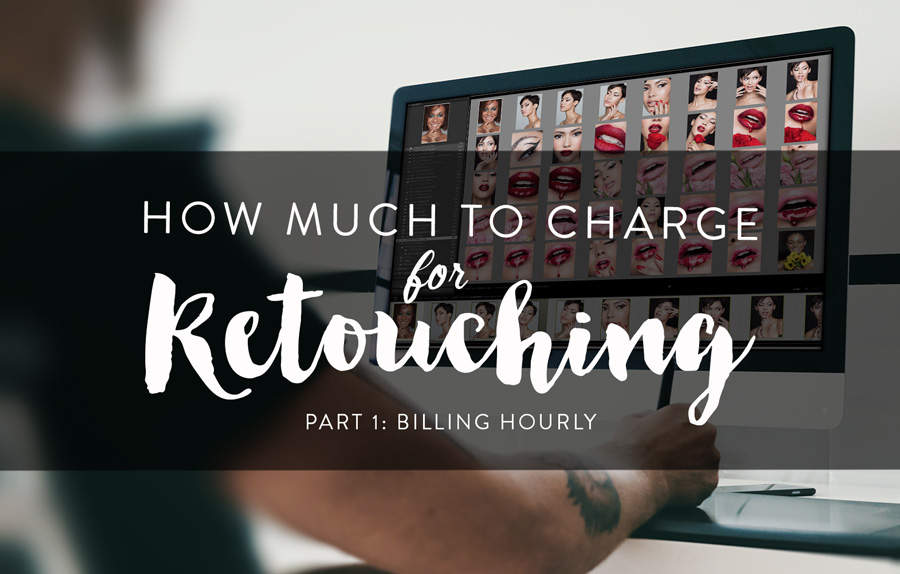In ‘How Much To Charge For Retouching Part One: Billing Hourly’ we took a look at hourly billing, the positives and negatives that it brings as a pricing model, and a rough idea of a typical hourly retoucher’s fee.
In Part Two we’ll discuss quoting and billing at a flat rate, a simple pre-agreed project fee, and the ideal time to test an increase to your rates.
Billing by Project
The Positive
A client wants a solid figure to factor into a budget or proposal, and a flat project fee allows for this. It’s a convenience for your client that gives them the peace of mind to proceed, and as a service provider, it behooves you to provide that.
Another plus point worth considering with project billing is that your fees won’t decrease as your skill and speed of working increase, in fact in real terms they go up. Under hourly billing, a project that once might have taken you two hours and now takes only one, would leave you billing just 50% of your old fee, probably for superior work. When you agree to a flat project fee, working more quickly and efficiently benefits you as your actual hourly compensation increases, in the case of the example given it actually doubles.
Logging hours across days to write invoices is tedious, and with a single pre-agreed project fee you’ll never have to worry about itemizing the time spent working for your client. With project billing, taking a lunch break to watch some videos of goats yelling on YouTube is a perfectly valid use of your time as long as you hit your deadline with a quality product.
With hourly billing, if you overestimate the time required to complete, you can end up sending a much smaller invoice than you’d hoped. This makes for very happy clients but can sometimes feel like the value of the work you provided and your contribution are left undercompensated, particularly for commercial campaigns. An agreed project fee prevents this, the client knows what they’re paying and you know what you’re being paid.
The Negative
Projects can really run over. When working for clients with whom you have a solid working relationship and a good understanding of their needs, you can usually be more confident in judging your expenditure of time, but with a new client, you can’t be sure the project won’t turn into a long, drawn out experimental exercise. ‘Can we change this?’ ‘here’s a new reference idea, can you do it this way instead?’ and ‘it’s nearly there but let’s try it a completely different way’ can turn into a frustrating experience.
Additionally, when you prepare a flat quote for a client you’ve assumed a great deal. You may have factored in the quirks of the images (oversharp skin, a wrinkled garment, a tricky mask), considered all of the clients markups, notes and requests, and be fairly confident you can set a projected price for them that gives you a fair compensation for your time across say, a dozen shots. Even with experience, these estimates can be wrong, and the outcome is that you could spend a day of your time beyond what you’d initially expected, watching the value of your time and input fall away.
Best of both worlds?
The Hourly vs Project Billing debate is as old as freelancing itself, and the only right answer is the one that’s right for you. Certainly it’s important to decide on a set hourly or day-rate, but consider giving your clients a project fee based on that hourly rate.
It’s not uncommon to deliver a quote by explaining that ‘based on my hourly of $X, we’re looking at a fifteen-hour project at a total of $Y.’ This gives you the opportunity to suggest that any revisions and additions to the project that fall significantly outside of the scope of the original brief may be billed at $X per hour. Always be sure to update your quote before starting that clock and explain why.
When to raise your rates
The best way to know when it’s time to up your fees is when you’re overworked. If you’ve been working for a few months and you’re booked into the weeks ahead, it’s a good sign that your demand is in a healthy enough position to ask for a higher fee from fresh inquiries. I remember one such time early in my career that I was so overworked that I quoted $1700 US for a project that at the time I’d have ordinarily billed around a fifth of that. My thinking was that if I don’t get the job I’m busy regardless, if I do get the job that’s enough money to buy the coffee I’m going to need. I got the job.
In situations where you feel overworked, such speculative quoting can be a minimal-risk opportunity to gauge your market. Upping your rates at a time when you have a finely balanced workload can be daunting, so do it when you can afford to take the hit if it doesn’t work out. Some clients with whom you have a good working relationship you may choose to keep on a low rate, others you may wish to inform ahead of time that your fees will be increasing. Give them plenty of notice for when this will come into effect.
Be aware that you will leave some clients behind when you increase your fees, but if as long as you’re replacing that lost income with more jobs at a higher rate, you’re on the right track.
Don’t undercharge!
As discussed in How Much To Charge For Retouching. Part One: Billing Hourly, as a freelancer work/life balance is important, and even when it’s possible to charge rates of a few dollars per small project, the rate of turnover you have to force yourself through to sustain an income may be exhausting.
Working on thousands of small transactions is a valid business model if you want to compete in that environment, but consider your time marketing, speaking to clients, even the electricity you’re using and in many economies to charge rock-bottom fees is an unsustainable model unless you’re pulling 60 hour weeks.
Ultimately billing sensibly doesn’t just help you, but the whole market. Retouching is a specialized skill, a profession, and a craft that takes years to develop proficiency, and that shouldn’t be devalued. If your goal is a sustainable personal income as a freelancer, don’t be tempted to fall in line with those around you charging the price of a coffee for two hours of their time.
A good client will recognize your worth, may even have been expecting and prepared to pay many times your quote.
You just need to be brave enough to say:
‘I know the value of my skill and experience, if you do too let’s work together.’














